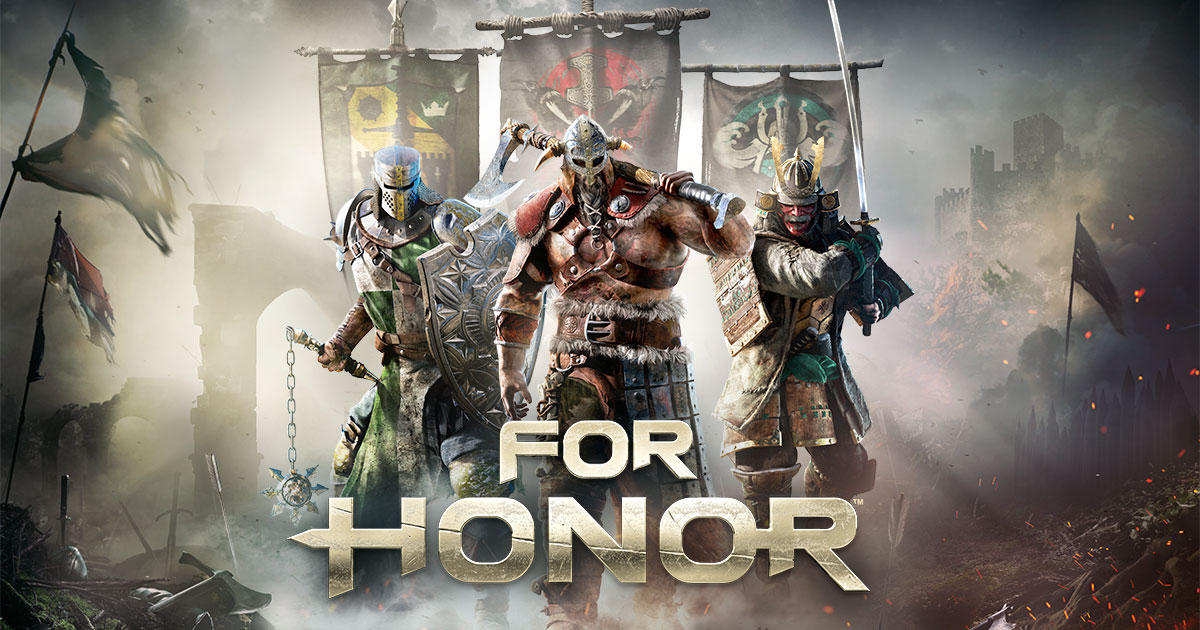During the Middle Ages, war was a much more personal experience than it is now. Guns weren’t available, and bombs couldn’t be used to dispatch of large groups of enemies along the battlefield. Instead, swords, axes, catapults and suits of armour were used to settle conflicts.
It’s this time period that Ubisoft has drawn from with its latest IP, For Honor. A game that harkens back to a time many, many moons ago, and uses it to bring forth some visceral, strategy-based swordplay.
Things begin with a cutscene, which shows a once (somewhat) peaceful land being torn apart by an unexpected earthquake of insane magnitude. It rips, pulls and cracks the world around it, destroying everything in sight and damaging vital resources in the process. Crops and plant life wither and die in the aftermath, and water becomes both scarce and worth fighting over. It’s in front of a tiny trickle of the stuff that a battle erupts with three combatants: a knight, a samurai and a viking. And it’s this battle that continues on for many years within the game’s tumultuous world.
In the middle of For Honor‘s bloody and corpse-filled campaign is Apollyon, a badass female warlord who wants nothing more than to create chaos. As the leader of the Blackstone Legion of knights, she uses strength, violence and manipulation to influence those around her, turning them into her own personal pawns.
It is Apollyon’s heinous, evil and wholly unnecessary meddling that creates the chaos that we must battle through over the course of this narrative. Her desire to make brother fight brother and turn clans on each other permeates throughout the game’s three act and eighteen mission-long campaign, which serves as an introduction of sorts.
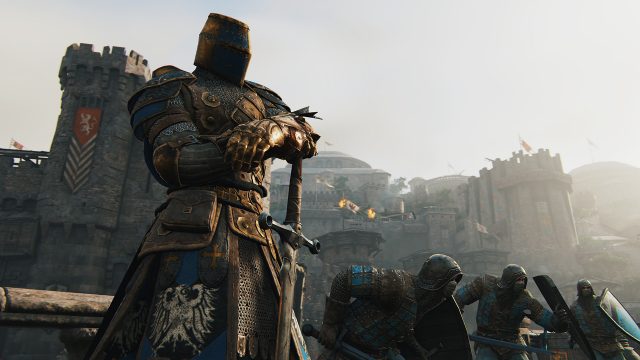
You see, For Honor wasn’t constructed with single player (or its campaign co-op) as a focus. Although the developers opted to include a story mode for those of us who generally prefer them, multiplayer is the main focal point here. As such, those who buy this game for its campaign will be doing themselves a disservice, unless they love the time period and happen to be itching for some close-up, sword-based combat.
Despite being several hours long and featuring its own experience system, the story portion of this historically-focused outing leaves a lot to be desired. It’s not bad, but it’s also not especially good, sitting somewhere in the middle thanks to level design and encounters that get boring and repetitive due to a lack of creative variety. Its story — which could have been epic if handled better — also ends up hitting with more of a thud than anything else, and doesn’t reach the heights that one would hope for. In fact, it often feels like more of an excuse for combat than anything else, and likely won’t be remembered in the coming years.
Then again, at least there is a campaign. It’s also good that Ubisoft put some effort into trying to create some replay value within it, by introducing feats, collectibles and the aforementioned experience system, even if it wasn’t entirely successful in doing so.
When you think of feats, picture them as timed or limited use perks or abilities, which can be used to aid you in your quest. For the most part, they’re pretty basic, offering things like personal healing, increased damage, or a buff for nearby allies. However, as you progress and level up you’ll start to unlock some slightly more unique ones, and will also find them scattered around each battlefield. It’s those limited types that are the most fun to use, as they offer things like fire arrows, poison trip bombs and flasks that explode when thrown. When combined with a difficulty system that offers extra experience for tougher options (those being normal, hard and realistic), you have the gist of For Honor‘s replay value. Needless to say, though, it’s pretty limited, and most players will only complete the story mode once, if they do so at all given how repetitive it can become.
To Ubisoft’s credit, a lot of said repetition comes from the subject matter, as there’s only so much that can be done with the Middle Ages. The setting was known for one-on-one duels, strategical sword fights and skirmishes involving multiple combatants on both sides of the coin. All of that is present here, as are a few varied moments where you’ll get to shoot a very basic and unfortunately forgettable mounted bow, hack at others while on an on-rails horse, or do the opposite and block as the cavalry ride by. Most of your time, though, will be spent hacking at one hit kill grunts before entering into combat with one to three more powerful enemies. Foes that will block and attack as you do, by watching your movements and your weapon’s positioning.
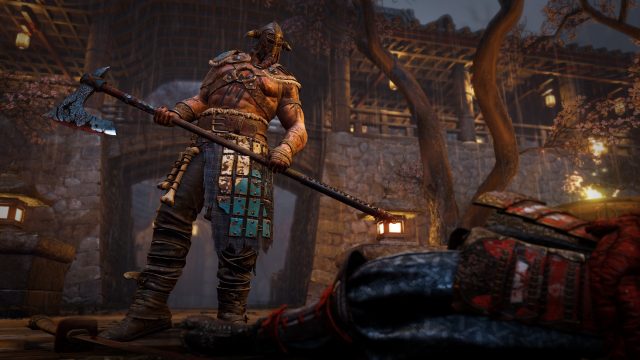
Therein, within its strategic battle system, is where the heart of For Honor lays. You see, instead of being a traditional hack n’ slash game (although it can feel a tiny bit like Dynasty Warriors whenever you’re ploughing through large amounts of grunts), this is a much more thought provoking engagement.
When you enter battle, whether it’s a one-on-one duel or something bigger, your goal will always be to outsmart your opponent. To this end, one must watch his enemy’s movements and look for openings. That means pressing the left trigger or L2 button to enter into a defensive stance, while moving the right joystick around to position your sword, or whatever weapon you’re using.
Combat consists of three different zones: left, upwards and right. Your key to survival, then — especially on the more challenging difficulties, and online where people are ruthless — is to both match and avoid where your opponent is hitting from. You move your weapon to the same (red highlighted) area to block, while pressing the attack button at the same time as his to parry. Then, when you want to attack, you’re tasked with looking for an opening that will allow you to hit flesh and do damage.
Those who become great at this game will end up being able to do all of the above with ease, but this is a system that is easy to learn yet hard to master. Adept foes will combine attacks from different locations, and some will even come carrying shields (or bearing skills) that make them harder to hit. For these, you’ll want to precede your light or heavy attacks with a shield break move or two, the second of which has a chance to push your foe off of a ledge, or send them sprawling into a nearby fire.
As you do battle, you’ll also want to keep a close eye on your stamina bar. Doing too much at once will drain it of its green energy, thus making your attacks become both strained and weak. And, if you end up using up every ounce of your stamina, you’ll see your chosen (and perhaps customized) avatar fall to the ground, opening him or herself up to easy damage.
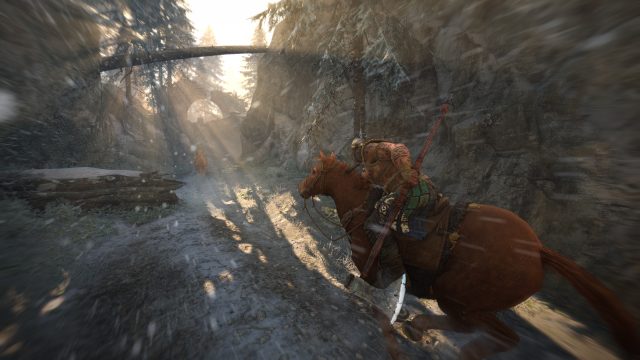
At times, this somewhat unique combat system can lead to some pretty epic duels, especially when it’s you against another human player. I say that because the enemy AI isn’t always ideal, and will sometimes fail to block any incoming attacks, leaving itself completely open until its death. Multiplayer was always the focus of this experience, though, and it’s definitely where For Honor shines most, even if it doesn’t exactly achieve greatness. Though, much like the campaign, it’s always better when things are one-on-one, because going up against more than one foe at a time can become frustrating.
Much like Rainbow Six Siege, For Honor contains an online mode that offers seasons of play. This is tied to its faction system, which has each player choose which of the three factions he or she will align with and battle for. Think of it like Risk, where everything you accomplish in different game modes can then be put to good use to shore up your side’s defences or attack others on the game’s world map. Then, at the end of each season, whichever group holds the most territory is the winner.
Due to the above, you’re always battling for the common good, so to speak. However, that’s not to say that each player isn’t fighting for him or herself, because experience points and loot are even greater motivators, especially in a game where equipping your customized avatar with better equipment will give you a statistical advantage on the battlefield. Hell, you can even upgrade your equipment, so long as you have the required dough.
While each player is free to customize his avatar as he sees fit, there are only several classes to choose from within each of the three factions. None are really the exact same, though, as each class offers its own faction-based perks, like greater defence or additional strength. On top of that, they all carry their own weapons, be it a sword, an axe or a spiked flail. And, as you progress, you’ll find yourself unlocking different parts for these weapons, such as a better flail’s head or a stronger wooden handle.
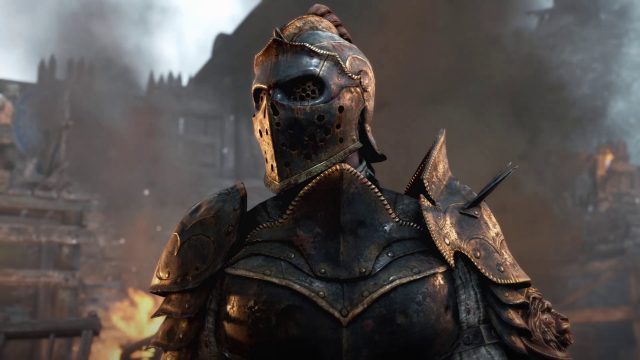
That said, I don’t want to be misleading and suggest that every new piece of loot you will earn will be a complete upgrade over what you’ve been using. No, as with all good loot systems, each piece has its pros and cons, and choosing one over the other will benefit you in one or two ways and perhaps hurt you in another. Finding the right fit for your play style is key, as it should be.
So, how about the game modes?
Well, as one would expect, For Honor‘s online options don’t skimp on round-based duels, as there are two types: one for one-on-one combatants, and one for those who’d like to go two-on-two. It also features a couple of common modes, which will be familiar to those who play shooters like Call of Duty or Battlefield. Those include traditional deathmatches and control challenges, wherein two teams fight to control each of three different points.
There are also events, but I was unable to access any when I tried. They’re likely saved for special occasions that will appear throughout the years that this game remains active.
It wasn’t until I finished the campaign that I really entered the online arena, and I think that helped me because I did pretty well. My first attempt to hop online didn’t go so well, though, because after waiting in the lobby for a surprising amount of time the map started to load and then froze almost immediately. This is one of the problems with For Honor‘s multiplayer, as its servers have been struggling to keep up with the demand. Connection errors and freezes such as this have been reported not only by myself, but by quite a few others, including friends of mine. So, don’t go in expecting a flawless experience at this point in time, as it doesn’t currently exist and it will likely take a bit of time (and some good patches) to address.
Despite its issues, the competitive multiplayer can be pretty fun, but is best served in smaller doses because of its style of gameplay and the amount of repetition it includes. Sure, there are those who will fall for it, like a moth to a flame, but the average player may not be able to get into the combat as much as they would a traditional shooter. Still, Ubisoft Montreal deserves credit for thinking outside of the box and delivering something new, even if its first attempt has some issues.
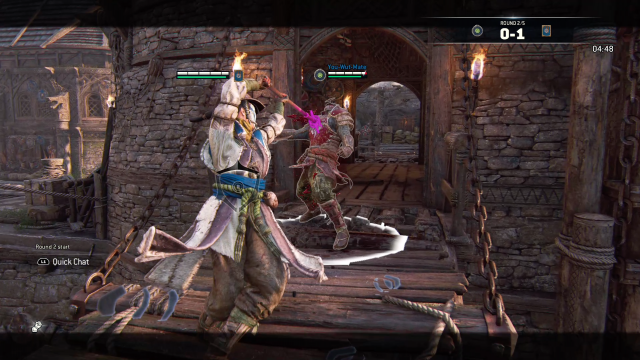
Presentation-wise, For Honor is a bit of a mixed bag, much like its gameplay. At times, it can look quite nice, especially when the player is placed in a forested area. Castles, forts and ruins are used quite often, though, and those environments tend to blend together after a while. Textures can also be hit and miss, as some show a good amount of detail whereas others feel like they’re stuck in an older game. This is also true of certain animations, with the ugliest ones occurring whenever you get to fire arrows at distant enemies. Not only does the launcher itself look quite bad, but the enemies’ resulting death animations are very underwhelming.
Certain cutscenes also look better than others, with some showing compression and pixellation. Not to an awful extent, but to the point where it can be noticeable.
For the most part, the sound fares better, with some badass metal-on-metal effects and boisterous explosions. Some of the vocal performances are better than others, however, and certain lines of dialogue aren’t the greatest. It all does the job, though, and creates a believable version of the Middle Ages.
At the end of the day, For Honor is a decent but unspectacular game, which deserves credit for thinking outside of the box. As ambitious as it is violent, its visceral combat brings something unique to the table, even if it’s repetitive and, at times, frustrating. Ubisoft can’t rest on its laurels here, though, because they’ve shipped a game with problems and need to address all of the connectivity issues before too long, else they risk frustrating their supporters and losing potential sales.
This review is based on the PlayStation 4 version of the game, which we were provided with. We played it on a PS4 Pro.

